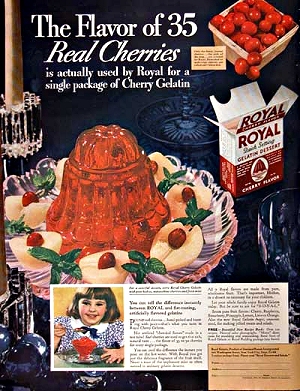Thursday, April 21, 2005
Page 15
REMINISCING (Column)
Royal Gelatin Mounts Competition to Jell-O Brand Gelatin
By ROGER M. GRACE
By 1930, Jell-O had several competitors. A decision that year by the Court of Customs and Patent Appeals recited that there were “many trade-marks registered” for gelatin desserts, naming four of them: Fruit-O-Jel, Advo Jel, Nu-Jell, and Easy Jell.
The court in that case rebuffed a challenge to trademark protection for Enzo Jel. The maker of Jell-O contended that Enzo Jel was an infringer because of the last syllable of Enzo, explaining that “O Jel is Jell-O backwards.”
Thwarted in its effort to mimic Jell-O’s name was another competitor, National Food Products Corporation, Inc. It applied for a trademark on its custard powder, Mel-O. The Court of Appeals for the District of Columbia in 1927 affirmed the commissioner of patents’ denial of registration based on the similarity of the names. The opinion recited:
“The opposer company is the owner of the trade-mark ‘Jell-O,’ which it and its predecessors have advertised at great expense since the year 1900, and which has become and is a very valuable asset in trade. The mark is used on a mixture containing gelatine, for making certain desserts, and also on a mixture containing no gelatine, for use in making desserts having the characteristics of ice cream, puddings, and various other similar desserts.”
The owner of Jell-O in 1900 when the advertising blitz began was the Genesee Pure Food Company, which in 1923 became the Jell-O Company, Inc. The Postum Cereal Co. (maker of Postum and Post cereals) bought Jell-O in 1925, and in 1929 changed its own name to General Foods Corporation.
It was Royal Gelatin which became the most formidable competitor Jell-O was ever to encounter.
I recall that in the 1950s, Royal Gelatin was a close competitor to Jell-O—boasting the endorsement of Howdy Doody, whose likeness appeared on packages.
The Royal Gelatin Hour which ran on radio from 1936-39 featured crooner Rudy Vallee.
Established in 1925, Royal Gelatin gained market share through extensive advertising—the means by which Jell-O had attained its preeminent position.
Royal boasted of superiority based on its use of fresh fruits. Jell-O, by contrast, was using artificial flavors for some of its varieties.
A 1935 magazine ad depicted a housewife holding near her nose a bowl of green gelatin, still apparently in liquid state, saying: “I changed to Royal the moment I smelled the difference.” A 1935 ad said:

Litigation developed over whose bright scientist was the first to reduce to practice a method of quickening the setting time for gelatin. The Court of Customs and Patent Appeals, in a 1939 decision, ruled that Royal Gelatin’s scientist beat out Jell-O’s.
In reciting who made what product, the court said:
“Standard Brands, Inc., through its subsidiary, Royal Baking Powder Co., manufactures and distributes ‘Royal Quick Setting Gelatin Dessert,’ while the Jell-O Company, a subsidiary of General Foods Corporation, produces and sells a gelatine product known as ‘Jell-O.’
Standard brands later merged with Nabisco.
In a Dec. 7, 2000 press release, the Federal Trade Commission announced its approval of the acquisition of Nabisco by Philip Morris—with provisos. One was that Philip Morris, which had purchased General Foods in 1995, could not gain a monopoly on gelatin dessert powder. The FTC noted:
“Philip Morris has an 86 percent share of the $212 million dry-mix gelatin dessert market, through its Kraft Foods Inc. subsidiary, which produces and sells Jell-O brand dry-mix gelatin desserts. Nabisco sells the Royal brand of dry-mix gelatin desserts, which has a 6 percent market share. Philip Morris and Nabisco are the only two significant sellers of branded dry-mix gelatin desserts in the United States; their products total $198 million in annual wholesale sales.”
Under a consent decree, Royal products were sold to Jel Sert.
Philip Morris (now known as Altria Group) owns Jell-O, Knox Gelatine, Certo and Sure-Jell.
Copyright 2005, Metropolitan News Company